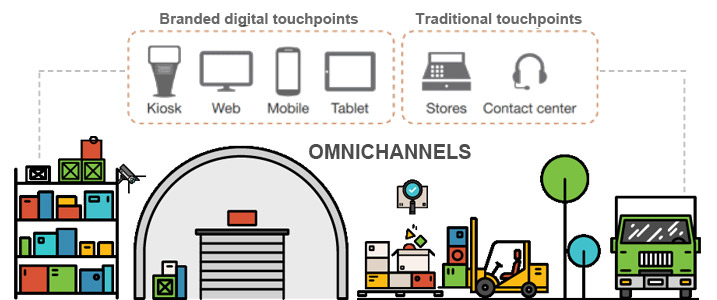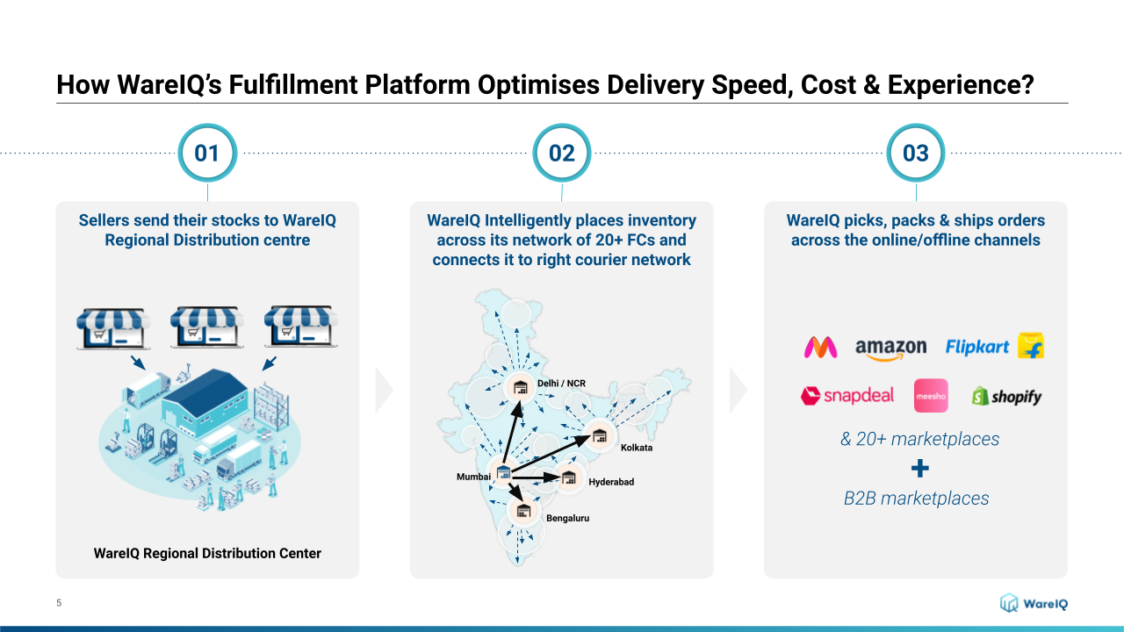Omnichannel Order Management: A Detailed Guide on the Meaning, Examples and Benefits of Omni Channel Management to eCommerce Retailers in 2025

What we already know is that consumer expectations in retail have shifted. This isn’t anything new. Many of these shifts in the online consumer behavior can be attributed to the on-demand economy. Instant satisfaction is the word of the game. So, what can businesses do to retain and attract customers? The solution is straightforward. Make purchasing simple by providing outstanding customer service, timely shipping and convenient fulfillment options. Omnichannel order management is critical to edging out competitors and remaining at the forefront of the ever-changing retail landscape and in this blog, we will take a detailed look at what it is.
- What is Omnichannel Order Management?
- Examples of the Working of Omnichannel Order Management
- Top 10 Benefits of Omnichannel Order Management
- How to Determine if You Need Omnichannel Order Management for Your Company in 2025?
- 3 Ways to Improve Your Omnichannel Order Management
- Conclusion
- Omnichannel Order Management: FAQs
What is Omnichannel Order Management?
A software system that allows you to access customer, order, and inventory information across multiple selling channels is known as omnichannel order management. It manages all orders across the company while providing the necessary information for eCommerce and point-of-sale systems to function properly.
Omnichannel order routing, store fulfillment and enterprise inventory are among the primary features. It also serves as a customer support platform, allowing you to see a comprehensive view of your business with real-time information in a single, unified location. In brief, omnichannel order management enables customers to shop and return items from any location. A comprehensive omnichannel OMS empowers both your employees and your consumers.
WareIQ, an eCommerce fulfillment company, empowers online brands with a superior-tech platform to compete with Amazon like service levels by bringing their average delivery timelines from 5-10 days to 1-2 days.
Examples of the Working of Omnichannel Order Management
Regardless of which channel captures an order, it goes through a number of states and steps that are all contained within the omnichannel order management system. Because no two orders are alike, the lifetime of each order may differ – certain phases or steps may be particularly unique to that specific order.
When a customer buys a product, the game is on. Time and honesty are critical. What’s the status of my order? How quickly will it be shipped? When can I expect it? These are the burning questions that your customers want to know the answers to. Assume a customer in Nagpur places an online order for a variety of products. After capturing the order, the OMS concludes that the quickest way to get the product into the hands of the consumer is to fulfill it from the Mumbai warehouse.
However, it is quickly established that one of the items in that warehouse is out of stock. This results in an exception because the entire order cannot be fulfilled there. The order gets diverted for fulfillment from the Hyderabad warehouse location in a matter of minutes. Depending on available inventory and delivery speed, the order could have been fulfilled from either warehouse. In this case, however, intelligent order routing indicated that the Hyderabad shop was the most efficient option.
Top 10 Benefits of Omnichannel Order Management

Consumer expectations indicate that they desire a consistent experience regardless of their habits along their purchasing process. This has generated difficulties for manufacturers and omnichannel retailers alike, as inventory and orders must now be managed across all channels. Adopting an omnichannel order management system would boost your client satisfaction. Furthermore, omnichannel order management can assist firms in improving operational efficiency and lowering expenses. Here are the top ten advantages of omnichannel order management for your company:
Improved Customer Experience
By controlling inventory and orders across all sales channels through omnichannel order management, manufacturers can deliver a smooth shopping experience for their customers. There are numerous reasons why improving customer experience is critical. Customers who are satisfied with a firm are more inclined to return and promote it to others. Customer satisfaction can also lead to decreased acquisition costs because satisfied consumers are less likely to take their business elsewhere. Finally, a better customer experience and customer feedback can make your consumers happy, that is always something to strive for.
Enhanced Operational Efficiency
By eliminating the need to manually reconcile inventory and orders across numerous channels, omnichannel order management can help manufacturers enhance operational efficiency. Because it has a direct impact on the bottom line, operational efficiency is critical for any firm. A corporation can save money and enhance revenue flow by streamlining its ecommerce operations and reducing waste. Furthermore, increased operational efficiency can help a business compete more effectively in the market by lowering costs and increasing productivity. Finally, operational efficiency is critical for every company that wishes to prosper.
Increased Cost Savings
If you want to enter a new market, you don’t have to open a new store in a new area – you can simply create a website and sell from your present location, allowing you to enter new markets from the comfort of your own home. Then there are the less tangible sources of cost savings. By employing omnichannel order management, you will eliminate the need for middlemen or third-party services by keeping everything in-house. Other cost savings come from improving client retention and centralizing all of your customers’ data.
Boosted Sales Figures
Every company’s lifeblood is sales. A company cannot live without sales. This is why higher sales are critical for companies of all sizes. To begin with, increased sales equal more revenue. This is critical for every organization since it allows them to reinvest in their operations, develop their activities and hire new employees. Increased sales can also lead to better brand recognition and awareness. Customers are more inclined to view a company favourably and suggest it to others when they see it selling more products or services.
Ultimately, greater revenues signify a company’s progress and expansion is critical for any company that wants to succeed in the long run. Businesses can secure their continued success and longevity by expanding their revenue]. If you want to enhance sales for your company, there are several things you may do:
- Create a Good Marketing Strategy for Your Company: This will ensure that potential buyers are aware of your products or services and what distinguishes them. Concentrate on delivering exceptional customer service; when clients have a pleasant experience with your company, they are far more likely to return and refer you to others.
- Always Be on the Lookout for Innovative Ways to Reach Out to Potential Customers: Make sure you’re doing everything you can to get your business in front of as many people as possible, whether it is through online marketing or traditional techniques like print ads or word-of-mouth marketing.
Improved Customer Retention
Omnichannel order management can help manufacturers boost client retention by providing a better customer experience. Furthermore, happy clients are more likely to refer people to your company, which can help you acquire new customers. Customers who are satisfied are also more loyal and less likely to switch to a competitor. So, while increased customer retention can lead to increased sales and profits, it can also assist you with building a stronger, more loyal client base.
Enhanced Supply Chain Management
By offering visibility into inventory and orders across all channels, omnichannel order management can help manufacturers enhance supply chain management. Today, supply chain management (SCM) is crucial for enterprises. Organizations can increase their overall performance and competitiveness by using an efficient and effective SCM system, monitoring its success and making changes as necessary.
Increased Visibility
By providing visibility into inventory and orders across all channels, an omnichannel order management approach can assist manufacturers in making better decisions about safety stock levels and promotions. Businesses that sell their products or services through several channels are more likely to be seen by potential customers. Companies can boost their chances of getting found by clients looking for what they have to offer by being present on many platforms.
Improved Data Quality
Omnichannel order management can help firms enhance data quality by offering visibility into inventory and orders across all channels. This improved data quality can lead to better stock-level and promotion decisions. Improved data quality is crucial for various reasons:
- Making sound business decisions requires accurate and dependable data
- High-quality data can assist businesses in improving their operational efficiency and performance
- Good data can assist businesses in developing more effective marketing strategies and better targeting their advertising efforts
- better data quality can help organizations of all sizes
Reduced Risk
Manufacturers can reduce risk by enhancing data quality and real-time inventory visibility with an omnichannel order management approach. One of the most serious concerns about selling online is the possibility of fraud. Businesses can avoid this risk by having several points of contact with their customers when employing an omnichannel approach. This allows any questionable behaviours to be swiftly discovered and addressed.
Another risk of selling online is the possibility of losing consumer information. Customers often enter their personal information such as their name, address and credit card number, when purchasing products or services online. Unauthorized parties may gain access to this information if it is not adequately safeguarded.
Improved Decision-Making
Improved data quality and visibility are essential omnichannel order management benefits that help manufacturers make better decisions about stock levels and promotions. Making decisions is a vital element of running a business and the capacity to make better judgments can mean the difference between success and failure. A successful decision is influenced by a number of elements and understanding these factors can help you make better decisions in your own business.
How to Determine if You Need Omnichannel Order Management for Your Company in 2025?
Customers nowadays are, without a doubt, more connected than ever before. They c can easily switch between online and offline channels, frequently utilizing numerous devices to research and acquire products or services. As a result, in order to compete, firms must embrace omnichannel order management.
Omnichannel order management seeks to deliver a consistent experience for customers regardless of how they interact with your company. This entails developing uniform messaging and branding across all channels and making it simple for customers to switch between them. It is crucial to remember, however, that not all firms will need to take an omnichannel approach. A single-channel technique may be sufficient in some circumstances. If you are unsure whether an omnichannel strategy is appropriate for your company, consider the following factors:
Your Clients
Do your clients seamlessly switch between online and offline channels? If this is the case, an omnichannel approach is most likely required to properly reach them.
Your Products and Services
Are your items or services complicated, necessitating substantial research prior to purchase? If this is the case, an omnichannel selling strategy will be beneficial in supplying customers with information.
Your Competitors
Are your competitors utilizing an omnichannel strategy? If this is the case, you may need to do so as well in order to remain competitive. Finally, only you can decide whether an omnichannel strategy is best for your company. However, if you want to reach more people and deliver a better experience, it is something to think about.
3 Ways to Improve Your Omnichannel Order Management
Examine Your Existing Order Management Technique
First, you should examine your present inventory and order management systems. How do you handle inventory and orders? Do you have a system that can be scaled as more sales channels are added? Is inventory synchronized across all of the channels via which you sell, or is it siloed? Do you use spreadsheets to keep track of your inventory or do you have a more advanced method? As your company grows, this can become a costly mistake. Spreadsheets are time-consuming and prone to human mistakes. They also lack the real-time features that order management software provides.
If a customer places an order, you’ll have to manually move inventory in your spreadsheets throughout the fulfillment process. As you add additional channels, the likelihood of costly errors grows. The sooner you transition to a unified order management system, the more efficient your omnichannel order management will be.
Recognize Your Customer’s Journey
The sooner you transition to a unified order management system, the better. Knowing how an omnichannel solution could fit into your organization begins with understanding your customer journey. Where do your customers shop for your product? Do you have a physical presence? If yes, do your clients prefer curbside pickup? Are people requesting refunds without visiting the store? Are they engaging with your brand on social media? Do you have products available on big marketplaces such as Amazon and Flipkart?
The bigger the number of touchpoints and channels, the greater the requirement for omnichannel order management software that connects them all. The more stem, the better.
Consider the Various Options You Have
There are various solutions available if you believe your eCommerce organization requires an omnichannel order management system to help you manage your shipping and logistics across several platforms. For example, if you need a comprehensive order and inventory management platform, there are many solutions that make it easy to expand into additional channels, and customer information, inventory and order management can be synced across all platforms. If you sell across many channels and need to streamline fulfillment, consider working with a 3PL like WareIQ, which also provides direct connections with major omnichannel solutions.
Conclusion
Omnichannel order management is not a new concept but it has grown in importance in recent years as consumers have grown more comfortable purchasing online and on mobile devices. The value of omnichannel order management is obvious for both retailers and customers. It can help retailers enhance revenue, inventory visibility and customer loyalty. It delivers a more convenient and smooth buying experience for customers.
However, order management for merchants using the omnichannel method is not without difficulties. It can be time-consuming and costly for merchants to adopt and it necessitates close collaboration across many departments inside the organization. Despite the hurdles, many companies are using omnichannel order management to sell across multiple channels. Brick-and-mortar retailers must discover ways to provide the same degree of convenience and customer service as their online competitors in order to compete in today’s market. If you are an omnichannel seller that needs assistance with managing and fulfilling orders across platforms, consider partnering with WareIQ.

WareIQ is one of India’s fastest-growing eCommerce fulfillment companies. We employ advanced technology to provide a vast number of eCommerce services. In regards to omnichannel order management, we provide a custom WMS that can integrate with more than 12 of the biggest eCommerce marketplaces such as Amazon, eBay, Flipkart, Meesho and more so that you can consolidate and view all your order and inventory data through one single dashboard.







